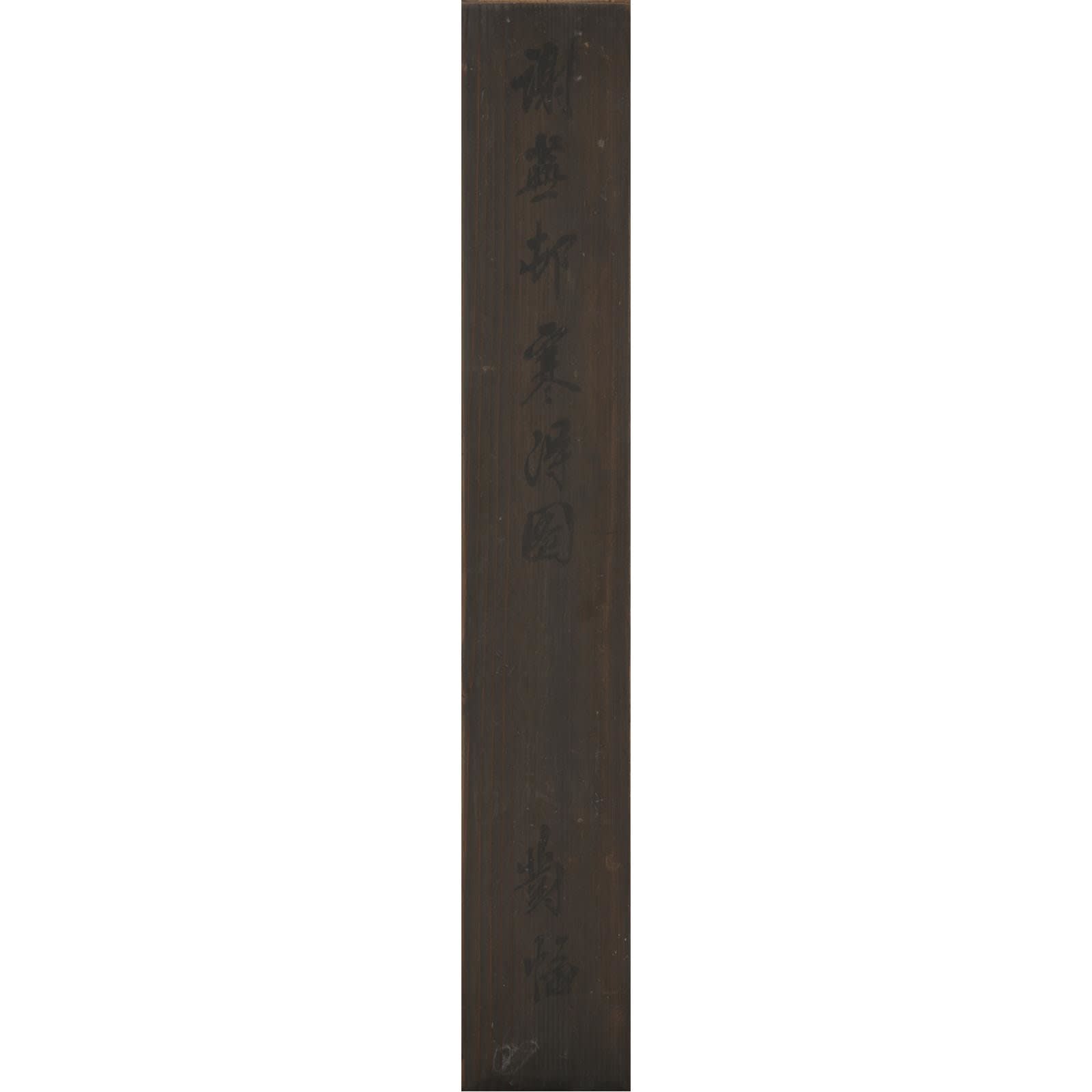Yosa Buson (1716–1783)
Hanshan and Shide
Ink and light color on paper, pair of hanging scrolls
With box authentication by Amenomori Hakusui (1878)
Seals: Choko-Shunsei
131 x 55.2 cm each
205 x 71 cm each (overall)
With box authentication by Amenomori Hakusui (1878)
Seals: Choko-Shunsei
131 x 55.2 cm each
205 x 71 cm each (overall)
Further images
Of all his paintings of Chinese figures, Buson perhaps depicted Hanshan and Shide the most. Buson zenshu (complete collection of works by Buson), volume six, includes eleven paintings of these eccentric Buddhist characters. Many of these consist of hanging scroll pairs portraying the two without background, however, finding similarities among them is difficult due to their individuality.
Hanshan’s smile with his mouth closed in this particular pair is striking, though this expression can be seen in the hanging scrolls of Shide (cat. nos. 193 and 369) and of Hanshan (cat. no. 370) in Buson zenhu, volume six. This facial feature likely had its beginning with Shide in cat. no. 193, which has an inscription that reads “Painted after Liu Jun, at a guest house in Nankai.” “Nankai” (literally, “southern sea”), here, is understood to mean Sanuki Province, where Buson resided from 1766 to 1768. “Liu Jun” refers to the Ming-dynasty Imperial Academy artist, who excelled at paintings of Buddhist and Daoist deities and figures. Liu Jun is also attributed to a painting of Hanshan and Shide at the Tokyo National Museum, though Buson emulated a different unknown work by the Chinese master whose Imperial Academy style appears to have in uenced the Japanese artist’s orthodox works made during his years in Sanuki.
Hanshan’s expression here, though perhaps derived from the Ming-dynasty Imperial Academy aesthetics, entirely re ects Buson’s style. Although the artist appears to have wielded an artless, carefree brush, the dynamic execution of the figure’s face and attire using thick and thin lines and energetic brushstrokes reveals otherwise. The supple lines used in rendering the pants recall Buson’s haiga, simple paintings accompanied by haiku verses.
The shading applied along the lines emphasizes the wrinkles in the faces and creases robes rather than creating a three-dimensional efect. This shading, mixed with black ink and a subtle suggestion of red, demonstrates Buson’s subdued, understated style, which represents the antithesis of an ostentatious, colorful, and flamboyant display of his skills.
Yosa Buson (haiku poet, painter; 1716−1783)
Also known as Taniguchi (Family name); Saicho; Yahantei; Shimei; Choso; Choko; Shunsei; Shain.
Settsu-born haiku poet and painter in mid Edo period. Learned haiku composition under Yahantei Soa. Established his individual painting style upon studying from those of different schools, Chinese paintings and imported painting albums. Active together with his contemporary, Ike no Taiga.
Hanshan’s smile with his mouth closed in this particular pair is striking, though this expression can be seen in the hanging scrolls of Shide (cat. nos. 193 and 369) and of Hanshan (cat. no. 370) in Buson zenhu, volume six. This facial feature likely had its beginning with Shide in cat. no. 193, which has an inscription that reads “Painted after Liu Jun, at a guest house in Nankai.” “Nankai” (literally, “southern sea”), here, is understood to mean Sanuki Province, where Buson resided from 1766 to 1768. “Liu Jun” refers to the Ming-dynasty Imperial Academy artist, who excelled at paintings of Buddhist and Daoist deities and figures. Liu Jun is also attributed to a painting of Hanshan and Shide at the Tokyo National Museum, though Buson emulated a different unknown work by the Chinese master whose Imperial Academy style appears to have in uenced the Japanese artist’s orthodox works made during his years in Sanuki.
Hanshan’s expression here, though perhaps derived from the Ming-dynasty Imperial Academy aesthetics, entirely re ects Buson’s style. Although the artist appears to have wielded an artless, carefree brush, the dynamic execution of the figure’s face and attire using thick and thin lines and energetic brushstrokes reveals otherwise. The supple lines used in rendering the pants recall Buson’s haiga, simple paintings accompanied by haiku verses.
The shading applied along the lines emphasizes the wrinkles in the faces and creases robes rather than creating a three-dimensional efect. This shading, mixed with black ink and a subtle suggestion of red, demonstrates Buson’s subdued, understated style, which represents the antithesis of an ostentatious, colorful, and flamboyant display of his skills.
Yosa Buson (haiku poet, painter; 1716−1783)
Also known as Taniguchi (Family name); Saicho; Yahantei; Shimei; Choso; Choko; Shunsei; Shain.
Settsu-born haiku poet and painter in mid Edo period. Learned haiku composition under Yahantei Soa. Established his individual painting style upon studying from those of different schools, Chinese paintings and imported painting albums. Active together with his contemporary, Ike no Taiga.













